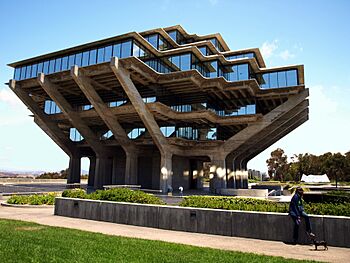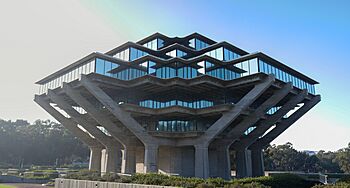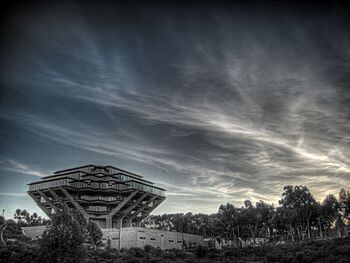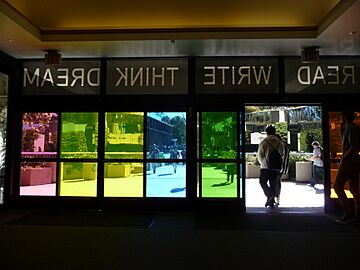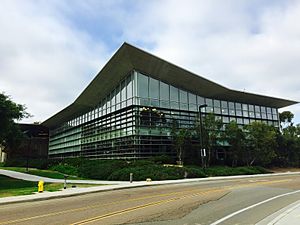Geisel Library facts for kids
Quick facts for kids Geisel Library |
|
|---|---|
 |
|
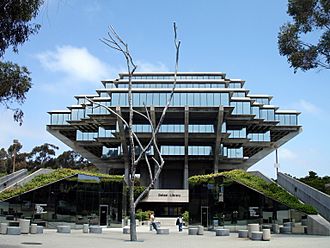 |
|
| Former names | Central Library, University Library |
| General information | |
| Architectural style | Brutalist / Futurist |
| Town or city | San Diego, California |
| Country | United States of America |
| Coordinates | 32°52′52″N 117°14′16″W / 32.88116°N 117.237651°W |
| Construction started | 1968 |
| Completed | 1970 |
| Renovated | 1993 |
| Cost | $5.12 million |
| Client | University of California San Diego |
| Height | 110 ft. |
| Dimensions | |
| Diameter | 200 ft. |
| Technical details | |
| Structural system | Reinforced concrete |
| Floor count | 8 |
| Design and construction | |
| Architect | William L. Pereira & Associates |
| Structural engineer | Brandow & Johnston |
| Services engineer | Frumhoff & Cohen (electrical) J.L. Hengstler & Associates (mechanical) |
| Main contractor | Nielsen Construction Swinerton Builders |
The Geisel Library is the main library at the University of California, San Diego (UCSD). It is named after Audrey Geisel and Theodor Seuss Geisel. Theodor Geisel is famous as the children's author Dr. Seuss.
This building has a very special design. People describe its style as a mix of "brutalism" and "futurism." This makes it a well-known landmark on the UCSD campus. The library is right in the middle of the university.
The famous architect William Pereira designed the library. It first opened in 1970 as the Central Library. It was updated in 1993 and then renamed Geisel Library in 1995. The UCSD Library system includes Geisel Library and the Sally T. WongAvery Library. It also has other storage places off campus.
The library holds over seven million books and other items. These help students and researchers learn and discover new things. It also has special collections. One of these is the Dr. Seuss Collection.
This collection has about 8,500 items. It includes original drawings, sketches, and notes by Dr. Seuss. It also has books, videos, photos, and souvenirs. These items show all of Dr. Seuss's creative work. They cover his life from 1919 until he passed away in 1991.
Contents
The Story of Geisel Library
In 1958, a man named Roger Revelle wanted to build a science and library center. This was part of his plan for a new university. When UCSD was built, a librarian named Melvin Voigt helped buy books. These books were for three new University of California campuses.
As the university grew, more departments were added. These included social sciences and humanities. Chancellor John Semple Galbraith realized a main library was needed. He wanted UCSD to have one of the best libraries in the UC system.
Galbraith created a committee to plan the new library. They hired architect William L. Pereira to design it. Pereira's team created the plans for the Central Library. His design placed the library in a new University Center area.
Pereira's plan included a round tower for the library. This shape would allow easy access to many books. The tower would sit on top of a main level. This lower level would hold staff offices and public areas.
Building the Library
Construction started in July 1968. The two main floors were built first. These floors formed the base for the tower. This base helped support the building of the upper levels. The main library building was finished in December 1969. It officially opened in March 1971.
The Central Library, along with other smaller libraries, supported the growing university. In 1990, a big expansion project began. Two new floors were added underground. This project also updated the existing building for safety. It cost $38 million and was finished in February 1993.
In 1995, Audrey Geisel gave $20 million to the library. She had also donated Dr. Seuss's original works in 1991. Because of her generous gifts, the library was renamed Geisel Library.
Recent Changes
Over the years, other UCSD library buildings changed. Some were updated, and some closed. In 2011, several smaller libraries closed. Their collections were moved into Geisel Library.
In 2015, the university announced another renovation for Geisel Library. This included building a café on the main level. The café is named Audrey's, after Audrey Geisel.
Geisel Library's Unique Design
The original building was designed by William Pereira in the late 1960s. It sits at the top of a canyon. The building's arches and floors are meant to look like hands holding up a stack of books.
Pereira first thought of a steel-framed building. But this would have been too expensive to build and maintain. So, he changed to a reinforced concrete structure. This allowed for a more artistic design. It also created more open spaces inside. Before building, a half-size model of a column was tested.
The five upper floors (the tower) hold books and study rooms. The two-story base has other library sections and computer labs. The tower is 8 stories tall, reaching 110 feet (33.5 meters).
Library Expansion
Soon after the library opened, it became too small. Student numbers had doubled. The library staff grew, and so did the book collections. Many books had to be stored elsewhere.
The original plan was to add more levels that stepped down into the canyon. However, a different plan was chosen in 1990. An underground addition was built at the front of the library. This new part was designed to blend with the original building.
The library entrance features an artwork by John Baldessari. It's called READ/WRITE/THINK/DREAM. Outside the library, there is also a life-size bronze statue. It shows Dr. Seuss with his famous character, The Cat in the Hat.
The Snake Path
On the east side of the library, you can find the Snake Path. This is a 560-foot-long path made of slate tiles. It winds its way towards the library. Along the path, there is a giant granite book. It has a quote from the poem Paradise Lost carved into it. There is also a small garden of fruit trees.
The Mystery of the Third Floor
The library has a unique numbering system for its floors. The lower levels are 1 and 2. The upper floors are 4 to 8. This makes people wonder: what happened to the third floor?
A popular story says that the building was not strong enough for all the books. So, the third floor was left empty. This is a common urban legend told about many university libraries.
But the truth is simpler! The "missing" third floor is actually an open outdoor area. It's a concrete platform outside the library. This area was meant for art displays and outdoor gatherings. It also serves as an emergency exit from the upper floors.
The doors to this third floor are usually locked. They are used for emergencies or by staff to move equipment. This helps keep the library quiet for people studying. There is also a "3.5" floor. This level holds utility connections and wiring for the building. It's mostly for maintenance.
What You Can Find Inside
The UC San Diego Library has over 7 million digital and print items. Most of these are organized by subject. But the library also has some very special collections. The Mandeville Special Collections and Archives include:
- American Institute of Wine & Food Culinary Collection
- Archive for New Poetry
- Baja California Collection
- California, San Diego, & the History of the West
- Don Cameron Allen Renaissance Collection
- Dr. Seuss Collection: This collection holds the works of Theodor Seuss Geisel (Dr. Seuss). It has about 8,500 items. These include original drawings, sketches, notes, books, and photos. The Dr. Seuss collection is very delicate. Only researchers with special permission can access it.
- East Asia Collection
- Hill Collection of Pacific Voyages: This collection was given to UCSD in 1974. It is one of the best collections about early sea voyages in the Pacific Ocean. It has over 2,000 items from the 16th to the mid-19th century. You can find ship logs from whaling trips and records from botanists who traveled by sea.
- The San Diego Technology Archive
- Scripps Institution of Oceanography Collections
- Southworth Spanish Civil War Collection
- Tuzin Archive for Melanesian Anthropology
- Twentieth-Century Science & Public Policy
- UC San Diego Archives
Other Library Locations
After some changes in 2011, Geisel Library and Sally T. WongAvery Library are the main library buildings on campus. The Sally T. WongAvery Library is located in the UC San Diego School of Medicine. Other library materials are stored at the Trade Street Storage Annex and the UC Southern Regional Library Facility.
See also
 In Spanish: Biblioteca Geisel para niños
In Spanish: Biblioteca Geisel para niños


